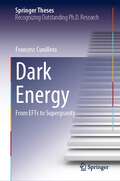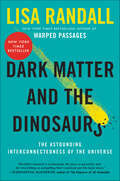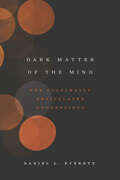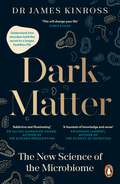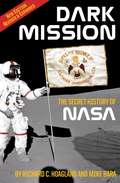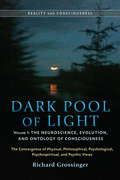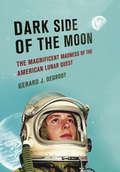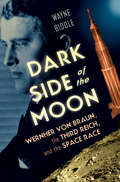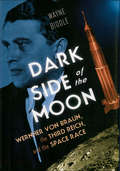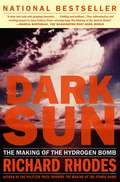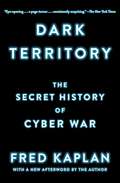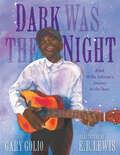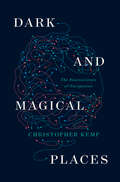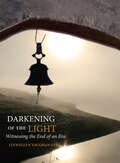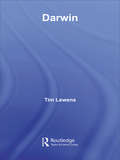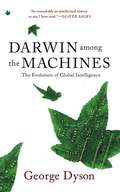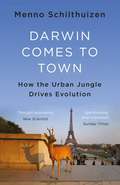- Table View
- List View
Dark Energy and the Formation of the Large Scale Structure of the Universe (Springer Theses)
by Jérôme GleyzesThis thesis presents several significant new results that shed light on two major puzzles of modern cosmology: the nature of inflation, the very early phase of the universe that is thought to have given rise to the large-scale structures that we observe today; and that of the current accelerated expansion. In particular, it develops a clean method for characterizing linear cosmological perturbations for general theories where gravity is modified and/or affected by a new component, called dark energy, responsible for the accelerated expansion. It proposes a new extension to what were long thought to be the most general scalar field theories devoid of instabilities, and demonstrates the robustness of the relation between the energy scale of inflation and the predicted amplitude of gravitational waves. Finally, it consolidates a set of consistency relations between correlation functions of the cosmological density field and investigates the phenomenological consequences of their potential violation. Presented in a clear, succinct and rigorous style, each of these original results is both profound and important and will leave a deep mark on the field.
Dark Energy: From EFTs to Supergravity (Springer Theses)
by Francesc CunilleraThis book addresses supergravity and supergravity-motivated effective field theories in the context of cosmological model building. Extracting information about quintessence from string theory has attracted much attention in the past few years. The question became more urgent very recently after the possibility of obtaining de Sitter space was called into question. Therefore, there is an interesting debate as to whether de Sitter space or, even, quintessence can be derived from a fundamental theory, string theory or otherwise. This is a very active field of research, and the topics covered in the book render this work very timely.Throughout the book, special care has been taken in demonstrating historical relevance of the field and describing the set of open questions motivating the state-of-the-art research. The first few chapters in each part provide a detailed review of standard perturbative and non-perturbative techniques in supergravity model building, as a way to prepare the reader for the more technical and original subsequent chapters. These early chapters also represent a self-contained review that would be useful for anyone planning to enter this challenging area of study. The subsequent chapters detail research in supergravity-motivated effective field theories, in the first part, and supergravity models, in the second part. One of the important conclusions in this book is that modelling quintessence in perturbative string theory is at least as challenging as modelling de Sitter, placing the wider programme on a collision course with observations.
Dark Hero of the Information Age: In Search of Norbert Wiener, The Father of Cybernetics
by Flo Conway Jim SiegelmanWiener's 1948 Cybernetics had a profound influence on computer, information, and social science pioneers including John von Neumann, Claude Shannon, and Margaret Mead. His visionary problem solving set off a scientific and technological revolution. But he also warned of a dark side to the cybernetic era, foreseeing the social, political, and economic upheavals that would begin to appear with the large- scale application of computers and automation. The brilliant mathematician's work fell into obscurity for reasons that journalists Conway and Siegelman trace through interviews with his family and colleagues and through newly declassified documents that show how the CIA and FBI sought to quash Wiener's social activism during the cold war. Annotation ©2004 Book News, Inc. , Portland, OR (booknews. com)
Dark Matter and the Dinosaurs: The Astounding Interconnectedness of the Universe
by Lisa Randall“Takes readers on illuminating scientific adventure, beginning sixty-six million years ago, that connects dinosaurs, comets, DNA, and the future of the planet.” —Huffington PostIn this brilliant exploration of our cosmic environment, the renowned particle physicist and New York Times–bestselling author of Warped Passages and Knocking on Heaven’s Door uses her research into dark matter to illuminate the startling connections between the furthest reaches of space and life here on Earth.Sixty-six million years ago, an object the size of a city descended from space to crash into Earth, creating a devastating cataclysm that killed off the dinosaurs, along with three-quarters of the other species on the planet. What was its origin? In Dark Matter and the Dinosaurs, Lisa Randall proposes it was a comet that was dislodged from its orbit as the Solar System passed through a disk of dark matter embedded in the Milky Way. In a sense, it might have been dark matter that killed the dinosaurs.Working through the background and consequences of this proposal, Randall shares with us the latest findings—established and speculative—regarding the nature and role of dark matter and the origin of the Universe, our galaxy, our Solar System, and life, along with the process by which scientists explore new concepts. In Dark Matter and the Dinosaurs, Randall tells a breathtaking story that weaves together the cosmos’ history and our own, illuminating the deep relationships that are critical to our world and the astonishing beauty inherent in the most familiar things.“Randall has woven a beautiful account of how life on Earth is intimately connected to the cosmos.” —The Daily Telegraph (UK)
Dark Matter of the Mind: The Culturally Articulated Unconscious
by Daniel L. EverettIs it in our nature to be altruistic, or evil, to make art, use tools, or create language? Is it in our nature to think in any particular way? For Daniel L. Everett, the answer is a resounding no: it isn't in our nature to do any of these things because human nature does not exist--at least not as we usually think of it. Flying in the face of major trends in Evolutionary Psychology and related fields, he offers a provocative and compelling argument in this book that the only thing humans are hardwired for is freedom: freedom from evolutionary instinct and freedom to adapt to a variety of environmental and cultural contexts. Everett sketches a blank-slate picture of human cognition that focuses not on what is in the mind but, rather, what the mind is in--namely, culture. He draws on years of field research among the Amazonian people of the Pirahã in order to carefully scrutinize various theories of cognitive instinct, including Noam Chomsky's foundational concept of universal grammar, Freud's notions of unconscious forces, Adolf Bastian's psychic unity of mankind, and works on massive modularity by evolutionary psychologists such as Leda Cosmides, John Tooby, Jerry Fodor, and Steven Pinker. Illuminating unique characteristics of the Pirahã language, he demonstrates just how differently various cultures can make us think and how vital culture is to our cognitive flexibility. Outlining the ways culture and individual psychology operate symbiotically, he posits a Buddhist-like conception of the cultural self as a set of experiences united by various apperceptions, episodic memories, ranked values, knowledge structures, and social roles--and not, in any shape or form, biological instinct. The result is fascinating portrait of the "dark matter of the mind," one that shows that our greatest evolutionary adaptation is adaptability itself.
Dark Matter: An Introduction
by Debasish MajumdarDark Matter: An Introduction tackles the rather recent but fast-growing subject of astroparticle physics, encompassing three main areas of fundamental physics: cosmology, particle physics, and astrophysics. Accordingly, the book discusses symmetries, conservation laws, relativity, and cosmological parameters and measurements, as well as the astroph
Dark Matter: The New Science of the Microbiome
by James Kinross‘Will change your life’ Chris Evans‘Completely fascinating’ Heston Blumenthal‘Important and devastating’ The TimesFrom a world-leading microbiome scientist and surgeon comes Dark Matter, a pioneering guide to hacking your microbiome for a healthier life.Our microbiome – the complex ecosystem of bacteria, viruses and other microbes inside us – is vital for our health and wellbeing. An invisible powerhouse whose potential we’re only just beginning to understand, it influences our mood and appetite, determines how fast we run and even who we choose as a partner.In this ground-breaking book, microbiome expert Dr James Kinross takes us on a guided tour of our extraordinary inner universe and highlights the damage we inflict when we don’t protect it. Showing through cutting-edge research and years of clinical experience, the practical steps we can all take to optimise the microbiome to live better, healthier lives.Now with a new, eye-opening afterword on the rise of home microbiome tests, IBS and FMTs. ‘Addictive and illuminating’ Dr Saliha Mahmood Ahmed, bestselling author of The Kitchen Prescription
Dark Mission
by Richard C. Hoagland Mike BaraThe New York Times bestseller about the strange history of NASA and its cover-ups regarding its origins and extraterrestrial architecture found on the moon and Mars is even more interesting in its new edition.Authors Richard C. Hoagland and Mike Bara include a new chapter about the discoveries made by ex-Nazi scientist and NASA stalwart Wernher von Braun regarding what he termed "alternate gravitational solutions," or the rewriting of Newtonian physics into hyperdimensional spheres.
Dark Nebulae, Dark Lanes, and Dust Belts (The Patrick Moore Practical Astronomy Series)
by Antony CookeThere are 'voids' obscuring all kinds of objects in the cosmos. Voids may be within an object, or between an object and us. Dark Nebulae, Dark Lanes, and Dust Lanes looks out into the deep sky at those apparent dark regions in space, which are among the most compelling telescopic destinations for amateur observers. One famous example is Barnard's dark nebulae - those striking dark clouds set against the background of stars in the Milky Way. But there are countless other less well known examples. These dark regions are often ignored altogether or commented upon only briefly in astronomy books, and it is all too easy to overlook the treasure trove they offer the observer. Dark Nebulae, Dark Lanes, and Dust Lanes is a great source of practical information for observers. Such voids may be successfully observed using conventional observing methods, but they are often far better seen with technologies such as light-pollution filters, CCD video cameras, and image intensifiers. This book explains the optimal ways to observe each object in detail.
Dark Pool of Light, Volume One
by Richard Grossinger Nick Herbert Jeffrey J. KripalIn books like Embryogenesis and Embryos, Galaxies, and Sentient Beings, author Richard Grossinger brought together the subjects of biological embryology and the esoteric process of human consciousness becoming embodied ("The embryo is the universe writing itself on its own body"). In Dark Pool of Light, his latest creation, Grossinger weaves neuroscience-based behaviorism and the phenomenology of "being" and reality together with psychological and psychospiritual views of "that single thing which is most difficult to understand or vindicate: our own existence." In 2008 Grossinger began studying with noted psychic teacher John Friedlander, who helped him refine his vision of cerebral and somatic awareness to still-subtler levels. "Dark Pool of Light began unnamed in the journals of my psychic work with John Friedlander," says Grossinger, "not so much a record of actual practices as insights from them and extensions out of them." An expansive inquiry into the nature of consciousness, the series examines the tension between the scientific and philosophical, and psychic views of the same phenomena, and includes "field notes" and experiential exercises that invite the reader to make their own explorations. Dark Pool of Light is divided into three volumes, which the author calls "movements"; the allusion to music is apt, for the book unfolds in a truly symphonic manner. In Volume 1, Grossinger begins with the scientific and philosophical, analytical views of reality, exploring the science, parascience, philosophy, and psychology of consciousness. Covering topics as diverse as current discoveries in neuroscience and the philosophy of the ancient Greeks, the book gives a broad overview of the bodies of knowledge concerning the nature of reality and consciousness.
Dark Remedy: The Impact of Thalidomide and Its Revival as a Vital Medicine
by Rock Brynner Trent StephensA remarkable medicine is now available that can successfully treat millions of people with multiple myeloma, brain tumors and other cancers, arthritis, lupus, Crohn's disease, multiple sclerosis, leprosy, tuberculosis, and AIDS. It's thalidomide-a drug with a chilling history. In the 1950s, this "safe" sedative was all the rage in Europe. Then one baby was born without ears, another with stunted limbs, then another with no limbs at all. In all, ten thousand severely deformed babies were born before thalidomide was banned. But two years ago, this brutal toxin was approved by the FDA. How did the most infamous drug of all time become one of the major players in modern medicine?In this irresistible medical detective story, Trent Stephens and Rock Brynner recount the history of thalidomide, a fascinating tale filled with villains and heroes, and bring us up to the present day, as scientists-Stephens among them-work to create and test an alternative drug that captures thalidomide's curative properties without its cruel side effects. The chronicle of a tragic chapter in the history of public health, Dark Remedy ends with great promise, as we put thalidomide to work for us, in the treatment of over a hundred diseases.
Dark Side of the Moon
by Gerard DegrootA selection of the History, Scientific American, and Quality Paperback Book ClubsFor a very brief moment during the 1960s, America was moonstruck. Boys dreamt of being an astronaut; girls dreamed of marrying one. Americans drank Tang, bought "space pens" that wrote upside down, wore clothes made of space age Mylar, and took imaginary rockets to the moon from theme parks scattered around the country.But despite the best efforts of a generation of scientists, the almost foolhardy heroics of the astronauts, and 35 billion dollars, the moon turned out to be a place of "magnificent desolation," to use Buzz Aldrin's words: a sterile rock of no purpose to anyone. In Dark Side of the Moon, Gerard J. DeGroot reveals how NASA cashed in on the Americans' thirst for heroes in an age of discontent and became obsessed with putting men in space. The moon mission was sold as a race which America could not afford to lose. Landing on the moon, it was argued, would be good for the economy, for politics, and for the soul. It could even win the Cold War. The great tragedy is that so much effort and expense was devoted to a small step that did virtually nothing for mankind.Drawing on meticulous archival research, DeGroot cuts through the myths constructed by the Eisenhower, Kennedy, and Johnson administrations and sustained by NASA ever since. He finds a gang of cynics, demagogues, scheming politicians, and corporations who amassed enormous power and profits by exploiting the fear of what the Russians might do in space.Exposing the truth behind one of the most revered fictions of American history, Dark Side of the Moon explains why the American space program has been caught in a state of purposeless wandering ever since Neil Armstrong descended from Apollo 11 and stepped onto the moon. The effort devoted to the space program was indeed magnificent and its cultural impact was profound, but the purpose of the program was as desolate and dry as lunar dust.
Dark Side of the Moon: Wernher Von Braun, The Third Reich, And The Space Race
by Wayne BiddleA stunning investigation of the roots of the first moon landing forty years ago. This illuminating story of the dawn of the space age reaches back to the reactionary modernism of the Third Reich, using the life of “rocket scientist” Wernher von Braun as its narrative path through the crumbling of Weimar Germany and the rise of the Nazi regime. Von Braun, a blinkered opportunist who could apply only tunnel vision to his meteoric career, stands as an archetype of myriad twentieth century technologists who thrived under regimes of military secrecy and unlimited money. His seamless transformation from developer of the deadly V-2 ballistic missile for Hitler to an American celebrity as the supposed genius behind the golden years of the U.S. space program in the 1950s and 1960s raises haunting questions about the culture of the Cold War, the shared values of technology in totalitarian and democratic societies, and the imperatives of material progress.
Dark Side of the Moon: Wernher von Braun, the Third Reich, and the Space Race
by Wayne BiddleA stunning investigation of the roots of the first moon landing forty years ago. This illuminating story of the dawn of the space age reaches back to the reactionary modernism of the Third Reich, using the life of "rocket scientist" Wernher von Braun as its narrative path through the crumbling of Weimar Germany and the rise of the Nazi regime. Von Braun, a blinkered opportunist who could apply only tunnel vision to his meteoric career, stands as an archetype of myriad twentieth century technologists who thrived under regimes of military secrecy and unlimited money. His seamless transformation from developer of the deadly V-2 ballistic missile for Hitler to an American celebrity as the supposed genius behind the golden years of the U.S. space program in the 1950s and 1960s raises haunting questions about the culture of the Cold War, the shared values of technology in totalitarian and democratic societies, and the imperatives of material progress.
Dark Sky, Dark Matter (Series In Astronomy And Astrophysics Ser.)
by J.M Overduin P.S WessonOlbers' paradox states that given the Universe is unbounded, governed by the standard laws of physics, and populated by light sources, the night sky should be ablaze with light. Obviously this is not so. However, the paradox does not lie in nature but in our understanding of physics. A Universe with a finite age, such as follows from big-bang theor
Dark Sun: The Making Of The Hydrogen Bomb
by Richard RhodesHere, for the first time, in a brilliant, panoramic portrait by the Pulitzer Prize-winning author of The Making of the Atomic Bomb, is the definitive, often shocking story of the politics and the science behind the development of the hydrogen bomb and the birth of the Cold War. Based on secret files in the United States and the former Soviet Union, this monumental work of history discloses how and why the United States decided to create the bomb that would dominate world politics for more than forty years.
Dark Territory: The Secret History of Cyber War
by Fred Kaplan&“An important, disturbing, and gripping history&” (Kirkus Reviews, starred review), the never-before-told story of the computer scientists and the NSA, Pentagon, and White House policymakers who invent and employ cyber wars—where every country can be a major power player and every hacker a mass destroyer.In June 1983, President Reagan watched the movie War Games, in which a teenager unwittingly hacks the Pentagon, and asked his top general if the scenario was plausible. The general said it was. This set in motion the first presidential directive on computer security. From the 1991 Gulf War to conflicts in Haiti, Serbia, Syria, the former Soviet republics, Iraq, and Iran, where cyber warfare played a significant role, Dark Territory chronicles a little-known past that shines an unsettling light on our future. Fred Kaplan probes the inner corridors of the National Security Agency, the beyond-top-secret cyber units in the Pentagon, the “information warfare” squads of the military services, and the national security debates in the White House to reveal the details of the officers, policymakers, scientists, and spies who devised this new form of warfare and who have been planning—and (more often than people know) fighting—these wars for decades. “An eye-opening history of our government’s efforts to effectively manage our national security in the face of the largely open global communications network established by the World Wide Web….Dark Territory is a page-turner [and] consistently surprising” (The New York Times).
Dark Was the Night: Blind Willie Johnson's Journey to the Stars
by Gary GolioThe poignant story of Blind Willie Johnson--the legendary Texas musician whose song "Dark Was the Night" was included on the Voyager I space probe's Golden RecordWillie Johnson was born in 1897, and from the beginning he loved to sing--and play his cigar box guitar. But his childhood was interrupted when he lost his mother and his sight. How does a blind boy make his way in the world? Fortunately for Willie, the music saved him and brought him back into the light. His powerful voice, combined with the wailing of his slide guitar, moved people. Willie made a name for himself performing on street corners all over Texas. And one day he hit it big when he got a record deal and his songs were played on the radio. Then in 1977, his song--"Dark Was the Night"--was chosen to light up the darkness when it was launched into space on the Voyager I space probe's famous Golden Record. His immortal song was selected for the way it expresses the loneliness humans all feel, while reminding us we're not alone.
Dark Winter
by John L. CaseyClimate change has been a perplexing problem for years. In Dark Winter, author John L. Casey, a former White House national space policy advisor, NASA headquarters consultant, and space shuttle engineer tells the truth about ominous changes taking place in the climate and the Sun. Casey's research into the Sun's activity, which began almost a decade ago, resulted in the discovery of a solar cycle that is now reversing from its global warming phase to that of dangerous global cooling for the next thirty years or more. This new cold climate will dramatically impact the world's citizens.
Dark and Magical Places: The Neuroscience of Navigation
by Christopher KempHow the brain helps us to understand and navigate space—and why, sometimes, it doesn’t work the way it should. Inside our heads we carry around an infinite and endlessly unfolding map of the world. Navigation is one of the most ancient neural abilities we have—older than language. In Dark and Magical Places, Christopher Kemp embarks on a journey to discover the remarkable extent of what our minds can do. Fueled by his own spatial shortcomings, Kemp describes the brain regions that orient us in space and the specialized neurons that do it. Place cells. Grid cells. He examines how the brain plans routes, recognizes landmarks, and makes sure we leave a room through a door instead of trying to leave through a painting. From the secrets of supernavigators like the indigenous hunters of the Bolivian rainforest to the confusing environments inhabited by people with place blindness, Kemp charts the myriad ways in which we find our way and explains the cutting-edge neuroscience behind them. How did Neanderthals navigate? Why do even seasoned hikers stray from the trail? What spatial skills do we inherit from our parents? How can smartphones and our reliance on GPS devices impact our brains? In engaging, engrossing language, Kemp unravels the mysteries of navigating and links the brain’s complex functions to the effects that diseases like Alzheimer’s, types of amnesia, and traumatic brain injuries have on our perception of the world around us. A book for anyone who has ever felt compelled to venture off the beaten path, Dark and Magical Places is a stirring reminder of the beauty in losing yourself to your surroundings. And the beauty in understanding how our brains can guide us home.
Darkening of the Light: Witnessing the End of an Era
by Llewellyn Vaughan-LeeA compelling insight into the impact that external, ecological damage has on the inner self, this spiritual exploration argues that although spiritual teachings reveal that events in the outer world are a reflection of changes taking place in the inner world, there is little awareness and discussion of how this outer darkening is reflected within. The book tells the story of changes that have been taking place in the inner worlds that belong to a collective spiritual destiny and the fate of the planet, changes that are as significant as the ecological devastation even as they are unreported and unacknowledged. It asserts that destruction of the surrounding world, as it continues, is reflected in the inner worlds of all people through a loss of sacred light, and the threat of a soulless wasteland looms large. The book seeks to address readers' futures as individuals and as a whole, and to inspire people to take responsibility for the earth and reclaim humanity's sacred role as its guardians.
Darmgesundheit und Mikrobiota: Ein Überblick über die Bedeutung der Darmbakterien für die Gesundheit (essentials)
by Dirk Haller Gabriele HörmannspergerDirk Haller und Gabriele Hörmannsperger geben einen Überblick über die zentrale Rolle des Darms und seiner Bewohner für die Gesundheit und vermitteln zusätzlich einen ersten Eindruck von den komplexen und dynamischen Interaktionen zwischen D+armbakterien und Wirt. Denn Forschungsergebnisse der letzten Jahre weisen darauf hin, dass die lange unbeachteten Darmbakterien (intestinale Mikrobiota) eine unerwartet zentrale Rolle für die Aufrechterhaltung der Gesundheit einnehmen. Die Forschung beschäftigt sich aktuell intensiv damit, die Grundlagen für ein funktionierendes und gesundheitsförderndes mikrobielles Ökosystem zu identifizieren. Dieses Wissen kann zukünftig für die Entwicklung gezielter Maßnahmen zur Prävention und Therapie Mikrobiota-assoziierter Erkrankungen eingesetzt werden.
Darwin (The Routledge Philosophers)
by Tim LewensIn this invaluable book, Tim Lewens shows in a clear and accessible manner how important Darwin is for philosophy and how his work has shaped and challenged the very nature of the subject. Beginning with an overview of Darwin’s life and work, the subsequent chapters discuss the full range of fundamental philosophical topics from a Darwinian perspective. These include natural selection; the origin and nature of species; the role of evidence in scientific enquiry; the theory of Intelligent Design; evolutionary approaches to the human mind; the implications of Darwin’s work for ethics and epistemology; and the question of how social and political thought needs to be updated in the light of a Darwinian understanding of human nature. A concluding chapter assesses the philosophical legacy of Darwin’s thought. Darwin is essential reading for anyone in the humanities, social sciences and sciences seeking a philosophical introduction to Darwin, or anyone simply seeking a philosophical companion to Darwin’s own writings.
Darwin Among the Machines: The Evolution Of Global Intelligence
by George DysonDarwin Among the Machines tells the story of humankind's journey into the digital wilderness. Introducing a cast of familiar and not-so-familiar characters, historian of science George B. Dyson traces the course of the information revolution, illuminating the lives and work of visionaries--from Thomas Hobbes to John von Neumann--who foresaw the development of artificial intelligence, artificial life, and artificial mind. This profound and elegant book derives both its title and its outlook from Samuel Butler's 1863 essay, "Darwin Among the Machines. " Observing the beginnings of miniaturization, self-reproduction, and telecommunication among machines, Butler predicted that nature's intelligence, only temporarily subservient to technology, would resurface to claim our creations as her own. Updating Butler's arguments, Dyson distills the historical record to chronicle the origins of digital telecommunications and the evolution of digital computers, beginning long before the time of Darwin and exploring the limits of Darwinian evolution to suggest what lies beyond. Weaving a cohesive narrative of his brilliant predecessors, Dyson constructs a straightforward, convincing, and occasionally frightening view of the evolution of mind in the global network, on a level transcending our own. Dyson concludes that we are in the midst of an experiment that echoes the prehistory of human intelligence and the origins of life. Just as the exchange of coded molecular instructions brought life as we know it to the early earth's primordial soup, and as language and mind combined to form the culture in which we live, so, in the digital universe, are computer programs and worldwide networks combining to produce an evolutionary theater in which the distinctions between nature and technology are increasingly obscured. Nature, argues Dyson, is on the side of the machines.
Darwin Comes to Town
by Menno SchilthuizenSee your city through fresh eyesWe are marching towards a future in which three-quarters of humans live in cities, and a large portion of the planet's landmass is urbanized. With much of the rest covered by human-shaped farms, pasture, and plantations, where can nature still go? To the cities -- is Menno Schilthuizen's answer in this remarkable book. And with more and more wildlife carving out new niches among humans, evolution takes a surprising turn. Urban animals evolve to become more cheeky and resourceful, city pigeons develop detox-plumage, and weeds growing from cracks in the pavement get a new type of seeds. City blackbirds are even on their way of becoming an entirely new species, which we could name Turdus urbanicus.Thanks to evolutionary adaptation taking place at unprecedented speeds, plants and animals are coming up with new ways of living in the seemingly hostile environments of asphalt and steel that we humans have created. We are on the verge of a new chapter in the history of life, Schilthuizen says -- a chapter in which much old biodiversity is, sadly, disappearing, but also one in which a new and exciting set of life forms is being born.Menno Schilthuizen shows us that evolution in cities can happen far more rapidly, and strangely, than Darwin had dared dream.

